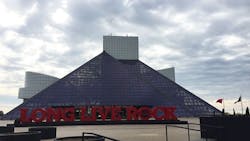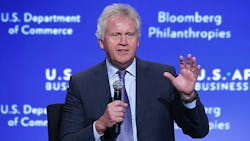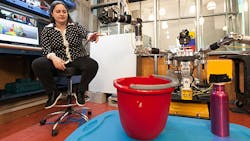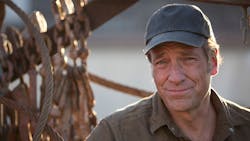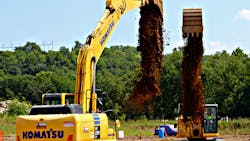The Tech Column: A Cleveland Postcard from the #mfgTechShow
CLEVELAND — If you schedule the first flight out of town and never linger on trade show floors the last morning or afternoon, you might be surprised just how quickly booths break down, how quickly carpet thatches are rolled and store, how quickly folks pack up and move on to the next event.
We wrapped our annual Manufacturing & Technology Conference & Expo a few minutes before 2 Wednesday afternoon, and within minutes everything and everybody started walking, rolling or just at least moving toward the exits of the Huntington Convention Center. Yes, even the Tesla Model X 100D (which starts at $101,800).
The show is a blur for us, and I imagine it’s a blur for our attendees, too. We packed four keynotes, six plant tours, more than three dozen hour-long presentations and a night at the Rock & Roll Hall of Fame into 54 hours. You need your program, or the show app. Or probably both, actually.
No two experiences are the same, of course. Everybody walks in with different goals, different questions, different expectations, and everybody walks out with their own perspective tweaked some. Everybody has different favorite moments, too.
I had two, both during the third and final day.
The first was the conversation at the last tech track presentation, “Leveraging the Edge to Unlock the Potential of the Industrial Internet of Things” with Rebecca Boll of GE Automation & Controls. I was tasked with moderating questions and answers for the last 30 or so minutes, and I had a list in front of me, but I used it just once. The room was that active. Question after question poured in — all of them focused and high-level — and the conversation flowed. I’ve covered manufacturing tech for more than two years now, but I’ve never worked in a plant, and I’m not an engineer. These were not questions I would ever think to ask. It was great to hear them. It was great to know more and more of our readers are interested in precision like this. And it made me want to provide even more thorough coverage for all of you. A big and sincere thanks to everybody who participated in that conversation.
The second was the fourth and final keynote, the last hour of the show, “Taking That One Giant Leap: Best Practices and Strategies for Getting Started on Your First IIoT Project” moderated by Karen Field, our executive director of content. I was pounding out some notes (I’ll have a story about it on the site later today) and one nugget of wisdom just danced like a sugarplum in my head. It came from Diego Tamburini, a manufacturing industry strategy in design and manufacturing for Autodesk, and it was a great strategy for IIoT — and, really, anything: “Start small. Move fast. Think big.”
Start small.
Move fast.
Think big.
You can apply that to an IIoT strategy, a marathon training plan, the long process of raising a child — anything at all. You should probably stop short of having it tattooed on you, but you could easily print motivational posters emblazoned with those words.
We’ll start small, move fast and think big as we plan our next M&T — which is scheduled for next May in Raleigh, North Carolina. See you there for more great presentations (and great moments), and probably some barbecue.
GE CEO Jeff Immelt / Alex Wong, Getty Images
IMMELT ON GLOBALIZATION (AND TECH): GE CEO Jeff Immelt visited Georgetown University last week and delivered a powerful talk about globalization and what GE as a company and we as a country might think about acting in the global market. The whole speech is available on Vimeo, and Immelt posted about 3,000 words of his prepared notes on LinkedIn. The whole talk is worth your time, but if you have just a minute or two, check out his thoughts on how tech ties into the conversation:
“American companies should reinvest in manufacturing. This is a source of competitive advantage and middle class jobs. By leading in additive manufacturing, we can make things anywhere in the world at low cost. In the past, productivity could be achieved only through low-cost labor in large factories. In the future, manufacturing will be driven by new materials, additive techniques and digitized plants. Factories will be smaller, more flexible and more globally mobile. Our goal is to make what we want, where we want, with workers who are more productive and more valuable.
“Another driver of speed and productivity for American companies is digitization. The combination of physical and analytical innovation is creating substantial value. In Pakistan, we are using analytics to improve energy efficiency and expand capacity. In India, we can use the internet to deliver healthcare to remote regions. In Ethiopia, engine analytics are improving airline productivity. Digitization makes us closer to our customers, delivering value around the world. And, digitization empowers ordinary people and that strengthens globalization. It allows small businesses to connect with a broader global ecosystem.”
C-LEARN at work, implemented on an MIT robot / MIT
ROBOT OF THE WEEK: C-LEARN, which isn’t a robot, but should be incredibly important in the near and longer-term future.
C-LEARN is a new system developed by researchers at MIT’s Computer Science and Artificial Intelligence Laboratory that allows people with no computer programming experience to teach a robot a task with a few rules. That robot can then transfer its new knowledge to another robot. What makes this really great (especially for the factory floor)? The robots can learn in different ways. Manufacturers could soon be able to use different types of robots and not have to program each of them separately.
Mike Rowe / Mike Segal
DIRTY (AND CLEAN) JOBS AREN’T GOING ANYWHERE: I talked with Mike Rowe late last month, mostly about the skills gap, and am wrapping up a story that will be on the website next week. One great thought from Rowe — the longtime host of Dirty Jobs and a major champion for teaching skills to American workers and for manufacturing — that didn’t make the final cut focused on industrial tech:
“I think it’s fantastic. I’m pro-progress. I’m kind of a Luddite on a personal level, with respect to my own ability to adapt — but in general, I think there’s only one way to go, and that’s forward. I don’t deny automation and robotics are going to have consequences, both intended and unintended, but the first thing is just to say I don’t bemoan it. I know it’s coming.
“I do think a lot about a quote from (Aldous) Huxley — I think it was Brave New World, when he said the greatest threat to freedom is total anarchy, but the second-greatest threat is total efficiency. Clearly, he’s talking about the difference between effectiveness and efficiencies, and that difference is interesting to me, but it’s kind of beside the point. The buggy whip makers are out of business, and the booksellers had a real problem when Kindle came along, and displacement theory is alive and well. But it never really happens the way we think. … We’re pretty sure everything is going to go the way of the 8-track, but not everything does. Most industries somehow adapt and somehow survive. I do believe massive change is coming, but it will be transformational. It won’t be completely and totally disruptive, because it never really is.”
WAN? TRENDING UP: Wide-area network (WAN) traffic increased 440% in manufacturing last year, according to a new report from Aryaka.
WAN traffic increased 296% in 2015, according to the same report, so the overall number is, as expected, trending upward. More than three-quarters of the WAN links used by manufacturers are high-speed or faster, and almost half of WAN traffic is HTTP or HTTPS thanks to that rise in cloud services adoption.
New Vuzix COO Paul Boris.
BIG WEEK FOR VUZIX: M&T always adds to the conversation, but we seldom break actual industry news at the show. We did this year. Paul Boris, who recently appeared in the pages of IW as VP of manufacturing industries at GE Digital, officially moved to Vuzix on Tuesday morning, hours before he appeared as a panelist at “Augmented Reality: Then, Now, Forever.” Boris is the new COO of the company, which is quickly becoming a major player in augmented reality. He was previously a board member.
Vuzix hit $1.21 million in revenue during the quarter ending March 31, according to its financial report released earlier this week, up 233% from a year ago. Its net loss for the quarter was $4.18 million, about 23 cents per share, a slight improvement from 26 cents per share year-over-year. A big chunk of that loss is tied to prepping for rapid growth — the company spent $1.67 million on R&D last quarter.
AND FOR UPSKILL: Vuzix wasn’t the only AR company represented on that M&T panel that made some headlines this week: Upskill — whose CTO, Jay Kim, moderated the hour — acquired Pristine on Tuesday in a move that adds proprietary cloud-based tech, and another American office.
Pristine is a leader in remote assistance and collaboration tech for the industrial market, with its EyeSight technology allowing users to dive into AR more quickly and with far less training. Upskill, which was called APX Labs until earlier this year, also adds Pristine’s Austin, Texas office to increase its roster of domestic locations to three.
Machinery jousting? Sure. / Extreme Sandbox
QUOTE OF THE WEEK: “Working the controls of an excavator is a little flying a helicopter in that it requires the use of both hands independently, as well as your feet. I say that having never flown a helicopter, and having been in an excavator for all of five minutes, but it is definitely more like flying a helicopter than driving a car. When do I get to crush something?” — Josh Dean, in his recent Popular Science feature Get Ready to Rumble.
Dean visited Extreme Sandbox, a former Shark Tank contestant and adventure company that has locations in Minnesota and Oklahoma and allows customers to operate bulldozers, excavators and other heavy machinery in a (really) controlled environment. I missed that episode of Shark Tank and hadn’t heard of the company before reading the story. This place sounds pretty awesome. I’d like to believe I wouldn’t crash.
About the Author
Matt LaWell
Staff Writer
Staff writer Matt LaWell explores news in manufacturing technology, covering the trends and developments in automation, robotics, digital tools and emerging technologies. He also reports on the best practices of the most successful high tech companies, including computer, electronics, and industrial machinery and equipment manufacturers.
Matt joined IndustryWeek in 2015 after six years at newspapers and magazines in West Virginia, North Carolina and Ohio, a season on the road with his wife writing about America and minor league baseball, and three years running a small business. He received his bachelor's degree in magazine journalism from Ohio University.
